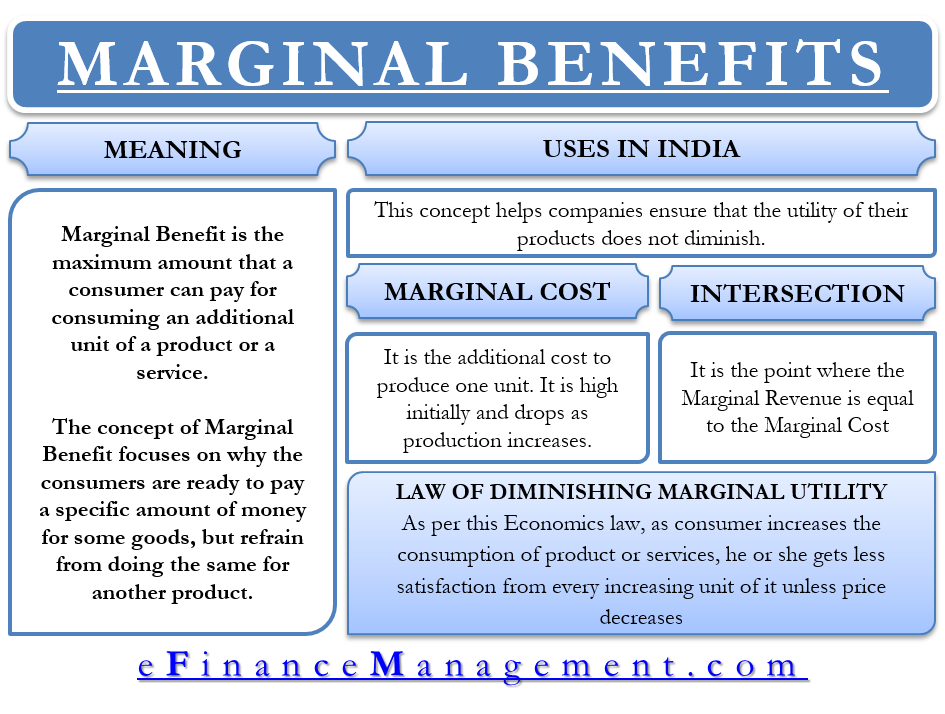Marginal Benefit is the maximum amount that a consumer can pay for consuming an additional unit of a product or a service. In simple words, the extra utility that a person derives from the purchase of a product or a service is the marginal benefit.
The concept of Marginal Benefit focuses on why the consumers are ready to pay a specific amount of money for some goods but refrain from doing the same for another product. As the consumer increases or drops the consumption of the goods or service, it affects its marginal utility as well. From the producer’s perspective, the marginal benefit is synonymous with the marginal revenue they earn.
Marginal Benefit is inversely proportional to the use of the product. This means that when a user increasingly starts using the product, the marginal benefit declines, and vice versa. It’s a very real-life situation where excessive use of any product or service leads to a drop in its value and satisfaction level the consumer gets overtime.
For example, the first slice of Pizza gives a lot of satisfaction to the user. The second slice may provide a bit less satisfaction, and the third even lesser. There will come a time when you will be fed up and don’t want to eat any more Pizza. The marginal benefit does not drop all of a sudden but decreases eventually with every slice of Pizza.
The same theory applies to the products. For instance, a product is usually of more value when it is new in the market. However, the same does not apply as the product and innovation gets older. Further, if the product is in short supply, people would be ready to pay more. But, once the supply of the product increases, the marginal utility drops.
For example, computers were very expensive in the 1990s as there were few companies making them. Now, supplies of PCs are in abundance, and as a result, their price has also come down.
Use of Marginal Benefit in Business
Although it is just a concept, marginal benefit plays an important role in the marketing and research aspect. Companies study and compare the customer’s marginal cost of an additional purchase with the marginal benefit. The concept helps marketing companies to understand the best price point that the customer would be ready to pay for a product.
For instance, the company prices one Pizza at $50 and informs customers that if they buy the second Pizza, it would be worth $40 only, resulting in a saving of $10. A company does that knowing that after the first Pizza, the utility for the customer would considerably go down. Therefore, they would not buy the same Pizza at $50. But, if a customer gets a discount, they might see some utility in buying the second Pizza.
Therefore, the concept helps companies ensure that the utility of their products does not diminish.

Exceptions to Marginal Benefits
There are some products whose marginal benefit does not change over time. For instance, medicines retain their utility as long as the patient needs them. Also, there are some staple items whose utility remains intact over time, for example, bread or milk.
Law of Diminishing Marginal Utility
The concept of marginal utility comes from the Law of Diminishing Marginal Utility. As per this Economics law, as the consumer increases the consumption of products or services, they get less satisfaction from every increasing unit of it. The only way to increase the utility of the next unit for the consumer is to decrease the price.
Marginal Cost
Marginal cost is the additional cost to produce one unit. Similar to marginal utility or benefit, marginal cost is also high initially and drops as production increases. The decrease in marginal cost is beneficial for the company, suggesting the overhead cost is spread over a large number of units. This happens because the manufacturer uses the full capacity of the equipment available.
However, over a period of time, this marginal cost starts rising again as the manufacturer decides to expand the capacity. For increasing the capacity, a company would need to buy additional equipment, resulting in an increase in the marginal cost. An increase in marginal cost put a negative effect on the marginal revenue, and it starts dropping.
Point of Intersection
As long as the marginal revenue or the marginal benefit for a company is greater than the marginal cost of producing the item, it will be profitable for the company to make the product. Therefore, a company can continue to increase production until it hits the profit-maximizing level of output. This point is the point of intersection, where the marginal revenue equals marginal cost. Beyond this point, costs for the company would increase, but producing less than that level leaves you with profit.

